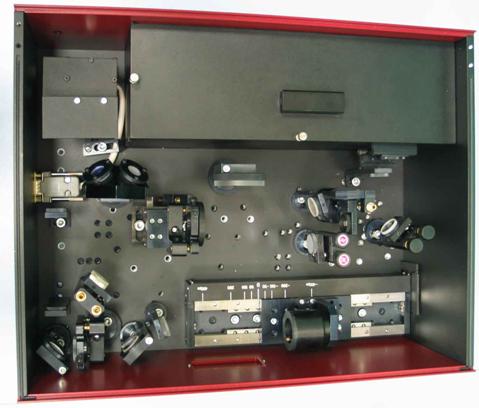
Jaws Laser System Cr:Forsterite
Multi-Terawatt Amplified Laser
Cortes-E Femtosecond TW Laser -
description
Cortes-800 40 TW 30 fs Amplified
Ti:Sapphire Laser
Cortes-O 200 TW Femtosecond Laser
Cortes-K Femtosecond Seed Laser for
Petawatt KrF Excimer Laser
OPCPA 200TW laser
Femtosecond Laser-Plasma Particle Accelerator
Charged particle accelerators have numerous uses, ranging from television tubes
to cancer therapy to the study of the fundamental forces of the universe. What
they all have in common is that the particles, such as electrons or protons, are
accelerated by electric or magnetic fields. Conventional accelerators , such as the 3 km-long one at the Stanford Linear Accelerator Center (SLAC), use metal cavities to rectify radio-frequency waves to repeatedly charged particles along the beam line. The SLAC has to be 3 km long to achieve its target particle energies because the
accelerating field of each cavity is limited. The field could be increased by
using radio waves of shorter wavelength and greater intensity, but both of these
properties are limited by the cavity: the cavity size limits the wavelength, and
high intensities cause electronic breakdown of the metal cavity walls.
Laser-plasma particle accelerators avoid these limits by utilizing plasma
instead of the cavity. With the highest-intensity pulses, particles might be
accelerated directly, the same way that relativistic electrons are generated by
the beam, allowing the plasma to be dispensed with (i.e. direct laser
acceleration, DLA). In the past few years, laser-driven electron and proton
accelerators have produced beams with energies greater than 50 MeV, comparable
to a single stage (a few meters long) of a conventional accelerator. The laser
system achieves the same energy in a millimeter. It will reduce the size of
current conventional accelerators by three orders of magnitude, offering an
low-cost and extremely compact high-energy electron source. Prompt laser
acceleration with high gradients is another advantages. For example, electron
beams of a few MeV whose the concentration of particles in the beam exceeds that
of beams made by conventional accelerators, mainly because the charges bunched
in one pulse of the beam have less time to blow it apart by its own
electrostatic forces.
In addition, scientists have shown that low-cost laser accelerators are suitable
for many of the same applications as conventional accelerators, such as
producing short-lived radioisotopes used in medical diagnostics and generating
neutron and positron beams for studies of materials. The laser systems create
beams that have a relatively broad spread of particle energies, however, which
is undesirable for some applications. Also, conventional systems routinely chain
together numerous accelerator stages, as in SLAC's 3-km collider and the
7-km-circumference main ring of the Tevatron at Fermilab. Laser
accelerators is a suitable candidate of electron injector for conventional
accelerator. Current research on laser accelerator systems is concentrated on
reducing the beam's energy spread and pulse duration and achieving multi-staging
to increase the beam's energy. Scientists are also exploring the use of
waveguides to increase the distance over which the wake field keeps accelerating
particles.
Del Mar Photonics connection: Our customers at
High-Field Physics and Ultrafast
Laboratory Institute of Atomic and Molecular Sciences,
Academia Sinica, Taipei, Taiwan use Rincon
TOCC (Third Order Cross Correlator) to determine the quality of laser
pulses. The third order cross-correlator Rincon has been specifically developed
for measuring a wide array of output parameters from ultrafast laser systems
including: contrast ratio of laser pulses, determining pulse pedestal, pre- and
post-pulses, and amplified spontaneous emission (ASE) in femtosecond systems. It
also provides information about the third-order cross-correlation function of
pulse intensity on a femtosecond scale and can be used for alignment of high
power femtosecond lasers.
Cross-correlator includes opto-mechanical assembly and electronics with USB
interface. System is easy to operate and includes a full set of user friendly
software tools for data collection and analysis.
Del Mar Photonics - Rincon cross correlator brochure
Rincon Third Order Cross-Correlator (TOCC)
Each Rincon is optimized for customer laser system and required range of
measurements.
The complete setup geometry, dimensions of non-linear crystals and some essential optics
are all function of laser parameters and user-chosen tradeoffs between
sensitivity, time resolution, time window, overall size etc.
We need the following information to set the tradeoffs and get all critical data necessary for
the
design which is optimized for your system.
1. Is the laser pulse chirped?
2. What is the spectral bandwidth?
3. What is the pulsewidth?
4a. What is the expected (or estimated) contrast ratio as a function of delay from peak
4b. What is the minimum necessary contrast ratio as a function of delay from peak
5. What is beam quality (i.e. beam divergence relative to diffraction-limited one)

To request a quote for Rincon cross-correlator please e-mail sales@dmphotonics.com with detailed answers to the questions above.
Jaws Laser System Cr:Forsterite
Multi-Terawatt Amplified Laser
Cortes-E Femtosecond TW Laser -
description
Cortes-800 40 TW 30 fs Amplified
Ti:Sapphire Laser
Cortes-O 200 TW Femtosecond Laser
Cortes-K Femtosecond Seed Laser for
Petawatt KrF Excimer Laser
OPCPA 200TW laser